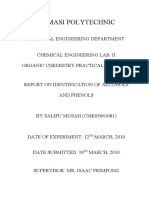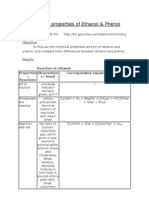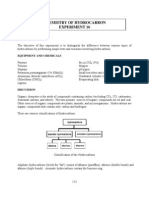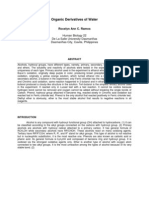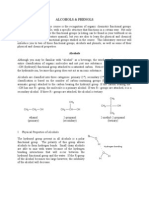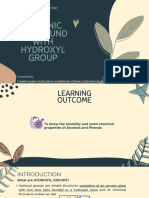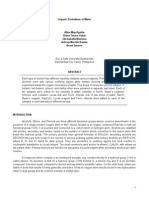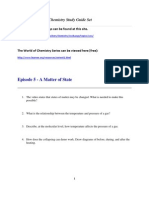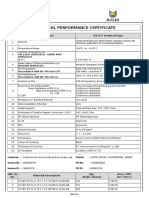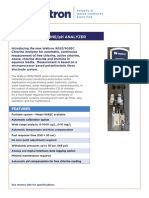Identification and Reaction of Alcohols
Identification and Reaction of Alcohols
Uploaded by
Vilmer IyanaCopyright:
Available Formats
Identification and Reaction of Alcohols
Identification and Reaction of Alcohols
Uploaded by
Vilmer IyanaOriginal Title
Copyright
Available Formats
Share this document
Did you find this document useful?
Is this content inappropriate?
Copyright:
Available Formats
Identification and Reaction of Alcohols
Identification and Reaction of Alcohols
Uploaded by
Vilmer IyanaCopyright:
Available Formats
Chemistry lab report
Name : LIM JOE JEAN SCM029428
FIS JULY INTAKE
Experiment 1 : Identification and reaction of alcohols and phenol
Objective : To study the physical and chemical properties of alcohol and phenol .
Apparatus and materials : Test tubes , water bath , distilled water , ethanol, 2-propanol , t-
butanol , phenol , Lucas reagent , sulphuric acid , potassium dichromate , sodium metal ,
phenolphthalein indicator , iron (III) chloride (CAUTION : phenol is very corrosive , never handle
it with your bare hand . Wear glove . )
Procedure :
A) Solubility test
1. 5ml of water was added into four labeled test tubes . 1ml of each of the following
liquids was poured into the labeled test tubes and shake .
2. If the substances dissolves were observed , and your observation was recorded on the
table .
3. Test tube no 1 was labeled as ethanol , the following test tube no 2, 3, 4 were labeled as
2-propanol, t-butanol and phenol .
B) Lucas test
1) 1ml of ethanol , 2-propanol , t-butanol and phenol were added into four separated dry ,
labeled test tubes .
2) 3ml of Lucas reagent was added into each test tubes , then inserted an stopper and
shaked gently to mix .
3) The solutions were allowed to stand at room temperature for 15 minutes . The
appearances of cloudiness indicated a reaction.
4) If there is no visible change , the test tube were immersed into a water bath that
maintained at approximately 60 C for 15 minutes and observed whether any change
occurs . (to apply heating)
5) The observation was recorded in table.
C) Oxidation reaction of alcohol
1) 2ml of ethanol and 0.5 ml of sulphuric acid were added in a test tubes .
2) 0.5ml of potassium dichromate was added in the test tubes and heated in a water bath
for 15 minutes .
3) The odour and colour change occurred during test.
4) Step 1-3 were repeated using 2-propanol , t-butanol , phenol .
D) Iron (III) chloride test
1) 5 drops of sample were placed into separate clean , dry test tubes to be tested .
2) 2 drops of Iron (III) chloride solution were added into each test tube
3) Any changes in solution were noted . A purple colour indicated the presence of phenol.
4) The observation were recorded in table .
Results :
TEST ETHANOL 2-PROPANOL t-BUTANOL PHENOL
Solubility Soluble Soluble Soluble Insoluble
Lucas No changes After boiling , the Milky A layer of crystal
mixture become formed .
milky .
Oxidation Green (positive ) Light green at the Yellowish Black (positive )
top (positive) (negative)
Iron (III) chloride Not changes No changes No changes Turn to purple
Observation :
Discussion :
Solubility:
Alcohols are soluble in water. This is due to the hydroxyl group in the alcohol which is able to
form hydrogen bons with water molecules. Alcohols with a smaller hydrocarbon chain are very
soluble. As the length of the hydrocarbon chain increases, the solubility in water decreases.
With four carbon in the hydrocarbon chain and higher, the decrease in solubility becomes visible
as the mixture forms two immiscible layers of liquid. The reason why the solubility decreases as
the length of hydrocarbon chain increases is because it is requires more energy to overcome the
hydrogen bonds between the alcohol molecules as the molecules are more tightly packed
together as the size and mass increases. Ethanol and 2-propanol is easy to dissolve , In case of
tert-butyl alcohol the alkyl group is branched and has less surface area i.e. less hydrophobic and
hence more soluble in water. Indeed , t-butanol is the most miscible in water . Phenol is
insoluble in water because of the presence of benzene ring . The phenyl group in phenol is
nonpolar and hydrophobic so it is insoluble in water . (CAUTION : phenol is very corrosive , never
handle it with your bare hand . Wear glove . )
Lucas reagent :
Lucas' reagent is a solution of saturated and anhydrous zinc chloride in concentrated
hydrochloric acid. This test is used to distinguish between water-soluble primary, secondary,
and tertiary alcohols. Some alcohols react with ZnCl2 in an acidic aqueous solution to give an
alkyl chloride. The Lucas test involves a substitution reaction, where the –OH group of the
alcohol is replaced by a Cl atom. The Lucas reagent consists of a mixture of HCl and ZnCl2 that
are dissolved in water. The mechanism of this reaction involves a carbocation intermediate: first
an OH- ion is removed from the alcohol, leaving the carbon atom in the molecule positively
charged. Then a Cl- ion adds to the positively charged carbon atom. The result is the alcohol is
converted to a chlorinated alkane, with the Cl occupying the spot that the –OH was in. Since
tertiary carbocation are much more stable than primary or secondary carbonations, tertiary
alcohols will react readily with the Lucas reagent. Secondary alcohols will react slowly (usually in
5-10 minutes). Primary alcohols will not react much at all, since a primary carbocation is so
unstable. Therefore, Tertiary alcohols (t-butanol) react immediately .The test tube will get hot,
and because the chloride is insoluble two layers may be apparent, or a cloudy dispersion forms.
Secondary alcohols (2-propanol) will become cloudy in 5 to 10 minutes. After heating slightly,
gives the white layer within 10 min. Primary alcohols (ethanol ) give no reaction at all .Phenol
doesn’t react under Lucas test .
Oxidation :
Primary alcohols can be oxidized to either aldehydes or carboxylic acids depending on the
reaction conditions. Secondary alcohols are oxidised to ketones. Tertiary alcohols aren't oxidized
by acidified sodium or potassium dichromate(VI) solution. There is no reaction whatsoever. This
is because tertiary alcohols don't have a hydrogen atom attached to that carbon for the oxygen
to remove . In this experiment , potassium dichromate is added as an oxidizing agent to
determine whether the alcohol will undergo oxidation or not . potassium dichromate is an
orange-yellow solution. The orange-yellow color is due to the Cr O ion. The 2-oxidation number
of chromium is +6. This reagent will oxidize primary and secondary alcohols and, in turn,
becomes reduced. The chromium in dichromate is reduced to chromic ion, Cr . A greenish
colored solution results. This color change from orange-yellow to green serves as an indicator
for the presence of a primary or secondary alcohol. A primary alcohol is oxidized first to an
aldehyde, which will be further oxidized to an acid. For phenol oxidation , phenols are easily
oxidized despite the absence of a hydrogen atom on the hydroxyl bearing carbon . Hence ,
oxidized water become a dark brown color associated with increased toxicity . Through the
experiment ,ethanol , 2 propanol and phenol show positive result and undergoes changes of
color . Only t-butanol show negative result because it doesn’t show any color changes during the
experiment .
Iron chloride(III) test :
Iron chloride(III) is used to identify the presence of phenol . when Iron chloride(III) added into
phenol solution , it will form a violet complex which is intense colour .meanwhile other alcohol
such as ethanol , 2-propanol and t-butanol have no reaction , remain colourless when Iron
chloride(III) added.
Question :
1) Define the term of functional group
A functional group is a portion of a molecule that is a recognizable/classified group of
bound atoms. In organic chemistry it is very common to see molecules comprised
mainly of a carbon backbone with functional groups attached to the chain. The
functional group gives the molecule its properties, regardless of what molecule contains
it*; they are centers of chemical reactivity. The functional groups within a molecule
need to be identified when naming.
2) Draw the structure of a molecule that contains hydroxyl functional group .
3) Draw structuralof primary alcohol , secondary alcohol and tertiary alcohol .
4) Based on the observation , you made in this experiment , answer the following
questions .
i) What happenes to a phenol with iron (III) chloride reagent ?
Phenol turns to a purple/violet colour solution.
ii) What happenes to a tertiary alcohol with Lucas reagent ?
Tertiary alcohol (t-butanol) turns milky/cloudy .
Conclusion :
Ethanol is the primary alcohol ; 2-propanol is the secondary alcohol ; t-butanol is the tertiary
alcohol .
You might also like
- LT - & Xii - Neet - GT - 1 (Set - 2) QP - 19.04.2024Document20 pagesLT - & Xii - Neet - GT - 1 (Set - 2) QP - 19.04.2024kishoretvis30% (1)
- Exercises-Topic 8Document6 pagesExercises-Topic 8Arturo AtienzaNo ratings yet
- Kami Export - Abbas Kamoona - Caie-Igcse-Chemistry-0620-Theory-V10Document29 pagesKami Export - Abbas Kamoona - Caie-Igcse-Chemistry-0620-Theory-V10Abbas KamoonaNo ratings yet
- Experiment 5 CHM207 Intermediate Organic Chemistry Reactions of Aliphatic Alcohols and PhenolDocument5 pagesExperiment 5 CHM207 Intermediate Organic Chemistry Reactions of Aliphatic Alcohols and PhenolFazsroul95% (19)
- Reactions of Aliphatic Alcohols and PhenolDocument9 pagesReactions of Aliphatic Alcohols and Phenolmoon star angelNo ratings yet
- Identification of Alcohols and PhenolsDocument15 pagesIdentification of Alcohols and PhenolsSALIFU91% (23)
- Alcohols and PhenolsDocument8 pagesAlcohols and PhenolsMomer83% (6)
- Chemical Properties of EthanolDocument7 pagesChemical Properties of EthanolKinkwan King100% (3)
- Group 1 - chm132 - Lab Report1 - An'nur Najwa Binti Abd Bayan - 2021463836Document10 pagesGroup 1 - chm132 - Lab Report1 - An'nur Najwa Binti Abd Bayan - 2021463836AN'NUR NAJWA ABD BAYANNo ratings yet
- Discussion Exp 1 CHM 301 Alcohol TestDocument4 pagesDiscussion Exp 1 CHM 301 Alcohol TestCik Mira YusoffNo ratings yet
- CHM207 Experiment 5Document14 pagesCHM207 Experiment 5NUR SABRINA MOHD SHAHNo ratings yet
- Experiment 6Document4 pagesExperiment 6rcarianeNo ratings yet
- Lab 3 FullDocument17 pagesLab 3 FullAmni MohamedNo ratings yet
- Report#8Document7 pagesReport#8Meredith GreyNo ratings yet
- CHM301 Lab Report AlcoholDocument9 pagesCHM301 Lab Report Alcohol2022680528No ratings yet
- Experiment 5 Properties of AlcoholDocument10 pagesExperiment 5 Properties of Alcoholsithaarthun-wp21No ratings yet
- Expt 5 8 ResultsDocument4 pagesExpt 5 8 ResultsAdrian SantolomaNo ratings yet
- Experiment 4 ChemDocument9 pagesExperiment 4 ChemLogen WolverineNo ratings yet
- Experiment No.3 CHM143Document9 pagesExperiment No.3 CHM143MaiSakurajima100% (1)
- Chemistry of Hydrocarbon Experiment 16: ObjectiveDocument10 pagesChemistry of Hydrocarbon Experiment 16: ObjectiveWena Sta Maria50% (2)
- Lab 4 Alcohol - 2011-2Document8 pagesLab 4 Alcohol - 2011-2Miisty Raiyen HallNo ratings yet
- Organic Derivatives of WaterDocument9 pagesOrganic Derivatives of Waterpagaduanjoshuaj8227100% (2)
- Discussion Lab 1Document2 pagesDiscussion Lab 1farahNo ratings yet
- Identification of Alcohols Lab ReportDocument9 pagesIdentification of Alcohols Lab ReportEzekiel WatsonNo ratings yet
- Exercise 7 (Organic Derivatives of Water)Document6 pagesExercise 7 (Organic Derivatives of Water)Wendell Kim Llaneta0% (1)
- Chemical Properties of PhenolDocument6 pagesChemical Properties of Phenol门门No ratings yet
- Aliphatic Hydrocarbons: LAB #1 Reactions of HydrocarbonsDocument7 pagesAliphatic Hydrocarbons: LAB #1 Reactions of HydrocarbonsJoshuaArryNo ratings yet
- Chemistry Report 3Document6 pagesChemistry Report 3Lih XuanNo ratings yet
- Organic Derivatives of WaterDocument6 pagesOrganic Derivatives of WaterCelyn Ann RamosNo ratings yet
- Experiment 5: Alcohols and Phenols: Eden Cabana, Niña Dominguez, Philip Gabriel Gimotea Locker No. 21Document7 pagesExperiment 5: Alcohols and Phenols: Eden Cabana, Niña Dominguez, Philip Gabriel Gimotea Locker No. 21Anonymous 75TDy2yNo ratings yet
- Experiment 12Document4 pagesExperiment 12Rohit BiswasNo ratings yet
- Tests For FlavonoidsDocument9 pagesTests For FlavonoidsPirya100% (1)
- Alco and PhenoDocument5 pagesAlco and PhenofastrackeNo ratings yet
- CHEM 31.1 - Alcohols and Phenols - Group 4Document9 pagesCHEM 31.1 - Alcohols and Phenols - Group 4Leica MinaNo ratings yet
- Lab Report CHM301Document15 pagesLab Report CHM301NURFATHIHA ARFANo ratings yet
- GROUP 3 - LABORATORY REPORT 4 - Compounds With Hydroxyl GroupDocument18 pagesGROUP 3 - LABORATORY REPORT 4 - Compounds With Hydroxyl GroupJESSIE FREDRICK DALANIELNo ratings yet
- Chemlab 7Document8 pagesChemlab 7Charmaine TabinNo ratings yet
- Experiment No. 2 AlcoholDocument5 pagesExperiment No. 2 AlcoholChristine MarcellanaNo ratings yet
- Experiment 4 & 5Document10 pagesExperiment 4 & 5Mhi Ismail0% (1)
- Experiment 7 ProcedureDocument6 pagesExperiment 7 ProcedureChristian BatayenNo ratings yet
- Activity 8 9 - OrgchemDocument7 pagesActivity 8 9 - OrgchemSherry Ann JabinesNo ratings yet
- Lab Report Act 6Document6 pagesLab Report Act 6Raya Ibarra LumogdangNo ratings yet
- Classification Tests For Hydroxyl and Carbonyl Containing CompoundsDocument7 pagesClassification Tests For Hydroxyl and Carbonyl Containing CompoundsSamantha Louise MondonedoNo ratings yet
- Alkohol (Repaired)Document38 pagesAlkohol (Repaired)LiviaAsriNo ratings yet
- Alcohols and Phenols Activity No. 13 Data Sheet I. Procedure and Observations: A. Alcohols 1. SolubilityDocument4 pagesAlcohols and Phenols Activity No. 13 Data Sheet I. Procedure and Observations: A. Alcohols 1. SolubilityJovan Paul DeldaNo ratings yet
- Lab Report Organic Chemistry (Experiment 5) Lim Wey LoonDocument15 pagesLab Report Organic Chemistry (Experiment 5) Lim Wey LoonWEY LOON LIMNo ratings yet
- Experiment 9 Formal ReportDocument5 pagesExperiment 9 Formal ReportTrishaNo ratings yet
- Experiment 2: Organic Chemistry For Environmental HealthDocument7 pagesExperiment 2: Organic Chemistry For Environmental HealthASYRANI ZULAIKHANo ratings yet
- Lab 10 Determination of and Unknown AlcoholDocument6 pagesLab 10 Determination of and Unknown AlcoholgioNo ratings yet
- CHM301 - Lab ManualDocument11 pagesCHM301 - Lab Manualsiti khadijahNo ratings yet
- PM6 LabreportDocument15 pagesPM6 LabreportJei y’allNo ratings yet
- Scientific Paper Exp 5Document4 pagesScientific Paper Exp 5Brent TenorioNo ratings yet
- SCH4U1Lab - Reactions of Hydrocarbons 2023-24 Dasha, Tara, NadinDocument5 pagesSCH4U1Lab - Reactions of Hydrocarbons 2023-24 Dasha, Tara, NadindinvernertoNo ratings yet
- CHM301 Laboratory ManualDocument19 pagesCHM301 Laboratory ManualAHLA AMANI AHMAD SYAYUTHINo ratings yet
- Praktikum Kimia Organik 1 Uin Jakarta PkimDocument31 pagesPraktikum Kimia Organik 1 Uin Jakarta PkimNur BillahNo ratings yet
- E3alcohol PDFDocument9 pagesE3alcohol PDFWinonaNo ratings yet
- AlcoholDocument25 pagesAlcoholKING RAFINo ratings yet
- Alcohols and PhenolsDocument11 pagesAlcohols and PhenolsRovic MelladoNo ratings yet
- Practice Makes Perfect in Chemistry: Acids, Bases, and Salts with AnswersFrom EverandPractice Makes Perfect in Chemistry: Acids, Bases, and Salts with AnswersNo ratings yet
- Atomic Structure and The Periodic TableDocument16 pagesAtomic Structure and The Periodic TableKrupa BorseNo ratings yet
- CHP 1 - The Particulate Nature of Matter 1 QPDocument10 pagesCHP 1 - The Particulate Nature of Matter 1 QPDhrumeelNo ratings yet
- The World of Chemistry Video Guide SetDocument10 pagesThe World of Chemistry Video Guide SetrkvNo ratings yet
- BiochemicDocument8 pagesBiochemicDhawal ModiNo ratings yet
- Boron FamilyDocument18 pagesBoron FamilyRaju SinghNo ratings yet
- ModuleDocument9 pagesModuleEspie Rose DumalagNo ratings yet
- 0625 w18 QP 22Document16 pages0625 w18 QP 22Dairin DindaNo ratings yet
- Royal Continental, Niger Project - Pi - 3751Document9 pagesRoyal Continental, Niger Project - Pi - 3751ashishvaidNo ratings yet
- Chapter 3 ProblemsDocument3 pagesChapter 3 ProblemsSteve HoNo ratings yet
- Chemical Reactions and Equations: 1. Objective QuestionsDocument62 pagesChemical Reactions and Equations: 1. Objective Questionssavani1979No ratings yet
- NA Lesson 2 Balancing Redox EquationsDocument19 pagesNA Lesson 2 Balancing Redox Equationsarwakhaled123loveNo ratings yet
- Simple ChlorinationDocument13 pagesSimple ChlorinationAnthony YUNo ratings yet
- Rates of Reaction 1Document39 pagesRates of Reaction 1Ricky LawNo ratings yet
- Y10 Science - Unit 2 ChemistryDocument30 pagesY10 Science - Unit 2 ChemistryCharmaine LIENo ratings yet
- University of Cambridge International Examinations International General Certifi Cate of Secondary EducationDocument16 pagesUniversity of Cambridge International Examinations International General Certifi Cate of Secondary EducationVarun PanickerNo ratings yet
- Hebeish Grop Catalog Data SheetDocument62 pagesHebeish Grop Catalog Data SheetrernestNo ratings yet
- O - LEVEL CHEMISTRY WORKSHEETS - Reactions QuestionsDocument21 pagesO - LEVEL CHEMISTRY WORKSHEETS - Reactions QuestionsFahim Ahmed75% (4)
- ملزمة التحليل الوزنيDocument30 pagesملزمة التحليل الوزنيkikikii1921681023No ratings yet
- Waltron Sales Sheet - Chlorine 9092Document2 pagesWaltron Sales Sheet - Chlorine 9092Wahyu TryNo ratings yet
- Name Reaction Organic Chemistry HandbookDocument8 pagesName Reaction Organic Chemistry Handbookdodeda4744No ratings yet
- Chemistry As Revision Questions F332Document23 pagesChemistry As Revision Questions F332LilliNo ratings yet
- Chemical EquilibriaDocument33 pagesChemical EquilibriafredNo ratings yet
- P-Block ElementsDocument282 pagesP-Block Elementssquaretillu0No ratings yet
- Wet Air Oxidation of Refinery Spent Caustic Sept 2000Document13 pagesWet Air Oxidation of Refinery Spent Caustic Sept 2000DAN IN-MARNo ratings yet
- T2-1P1 TDocument26 pagesT2-1P1 TAnonymous yHDi3jcYOB0% (1)
- Mmabr PDFDocument10 pagesMmabr PDFVlad AncutaNo ratings yet
- 0620 Chemistry: MARK SCHEME For The May/June 2012 Question Paper For The Guidance of TeachersDocument6 pages0620 Chemistry: MARK SCHEME For The May/June 2012 Question Paper For The Guidance of TeachersAbrar Abdallah SiamNo ratings yet





